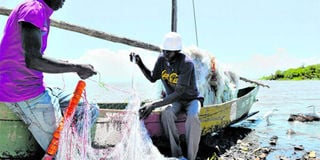Livelihoods at stake as species in Lake Victoria dwindle

Fishermen repair their fishing nets at Dunga Beach in Lake Victoria on November 2, 2015. PHOTO| FILE| NATION MEDIA GROUP
Three-quarters of animals and plants in Lake Victoria are threatened with extinction, a new study has shown.
The report titled Freshwater biodiversity in the Lake Victoria Basin showed that 76 per cent of living organisms in the Lake Victoria Basin, including fish, aquatic plants and the environment are threatened with extinction.
The study by the International Union for Conservation of Nature (IUCN) identified and mapped 39 areas that are important for biodiversity across the Lake Victoria Basin that includes rivers, lakes and wetlands.
IUCN then assessed the extinction risk of 651 native freshwater species including fish, molluscs, dragonflies, crabs, shrimps and aquatic plants.
The assessment revealed that of the freshwater species assessed, 204 are endemic to the Lake Victoria Basin and 76 per cent are at risk of extinction.
“The Lake Victoria Basin is incredibly rich in unique species found nowhere else on earth, yet its biodiversity is being decimated,” said Will Darwall, co-author and head of IUCN’s Freshwater Biodiversity Unit.
IMPORTANT SOURCES OF FOOD
These freshwater species are important sources of food, medicine and construction material for millions of people living in the basin, therefore, their extinction would put their livelihoods at stake.
The threats to biodiversity include overfishing, poor fishing practices and environmental degradation as wetlands are converted to agricultural land.
Water hyacinth that covers close to 10 per cent of the lake’s surface also reduces oxygen and nutrient availability for native species.
Catherine Sayer, IUCN Programme Officer and co-author of the report, also noted that the Lake Victoria Basin is home to hundreds of species that have not yet been described, meaning that the number of species at risk of extinction could be even higher than predicted.
“We know very little about many species in the basin. It is important that we build on the data used in this report to fully understand the species distributions and populations, and threats to the species, in order to minimise the future impact of biodiversity loss on local communities,” she said.
Given that Lake Victoria is the world’s second largest freshwater lake with a catchment area that includes parts of Kenya, Tanzania, Uganda, Burundi and Rwanda, the researchers recommend sustainable land and water management, as well as conservation programmes.


